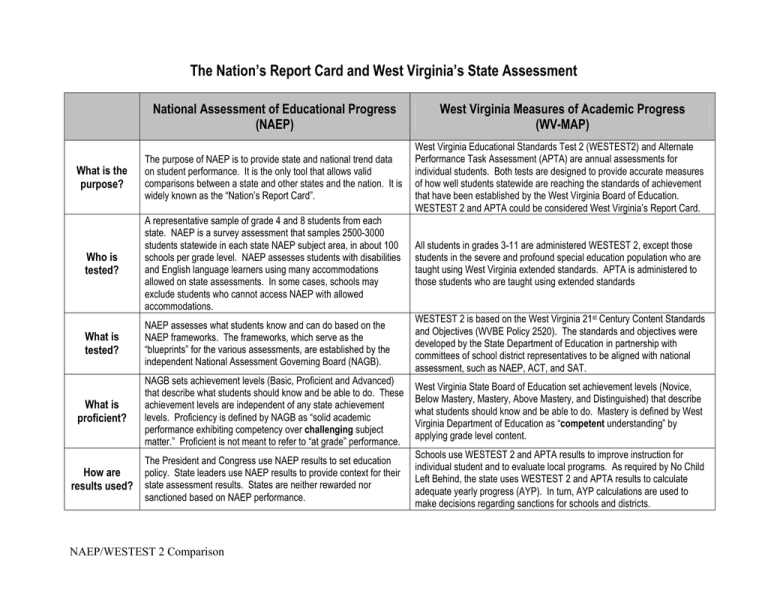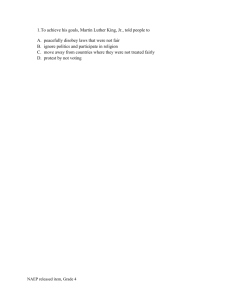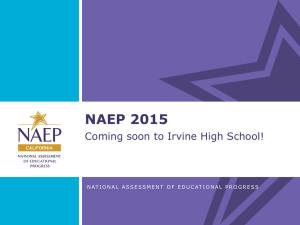The Nation’s Report Card and West Virginia’s State Assessment (NAEP)
advertisement

The Nation’s Report Card and West Virginia’s State Assessment National Assessment of Educational Progress (NAEP) West Virginia Measures of Academic Progress (WV-MAP) What is the purpose? The purpose of NAEP is to provide state and national trend data on student performance. It is the only tool that allows valid comparisons between a state and other states and the nation. It is widely known as the “Nation’s Report Card”. West Virginia Educational Standards Test 2 (WESTEST2) and Alternate Performance Task Assessment (APTA) are annual assessments for individual students. Both tests are designed to provide accurate measures of how well students statewide are reaching the standards of achievement that have been established by the West Virginia Board of Education. WESTEST 2 and APTA could be considered West Virginia’s Report Card. Who is tested? A representative sample of grade 4 and 8 students from each state. NAEP is a survey assessment that samples 2500-3000 students statewide in each state NAEP subject area, in about 100 schools per grade level. NAEP assesses students with disabilities and English language learners using many accommodations allowed on state assessments. In some cases, schools may exclude students who cannot access NAEP with allowed accommodations. All students in grades 3-11 are administered WESTEST 2, except those students in the severe and profound special education population who are taught using West Virginia extended standards. APTA is administered to those students who are taught using extended standards What is tested? NAEP assesses what students know and can do based on the NAEP frameworks. The frameworks, which serve as the “blueprints” for the various assessments, are established by the independent National Assessment Governing Board (NAGB). WESTEST 2 is based on the West Virginia 21st Century Content Standards and Objectives (WVBE Policy 2520). The standards and objectives were developed by the State Department of Education in partnership with committees of school district representatives to be aligned with national assessment, such as NAEP, ACT, and SAT. What is proficient? NAGB sets achievement levels (Basic, Proficient and Advanced) that describe what students should know and be able to do. These achievement levels are independent of any state achievement levels. Proficiency is defined by NAGB as “solid academic performance exhibiting competency over challenging subject matter.” Proficient is not meant to refer to “at grade” performance. West Virginia State Board of Education set achievement levels (Novice, Below Mastery, Mastery, Above Mastery, and Distinguished) that describe what students should know and be able to do. Mastery is defined by West Virginia Department of Education as “competent understanding” by applying grade level content. How are results used? The President and Congress use NAEP results to set education policy. State leaders use NAEP results to provide context for their state assessment results. States are neither rewarded nor sanctioned based on NAEP performance. Schools use WESTEST 2 and APTA results to improve instruction for individual student and to evaluate local programs. As required by No Child Left Behind, the state uses WESTEST 2 and APTA results to calculate adequate yearly progress (AYP). In turn, AYP calculations are used to make decisions regarding sanctions for schools and districts. NAEP/WESTEST 2 Comparison

